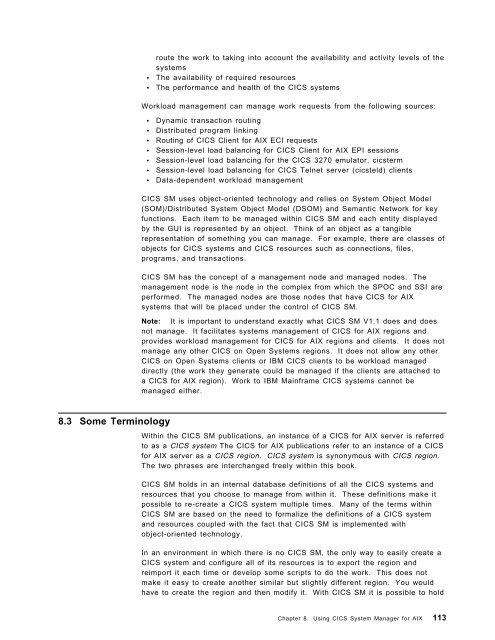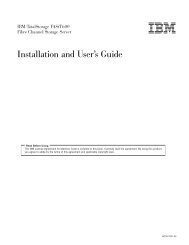Addressing OLTP Solutions with CICS: The Transaction Server ... - Ibm
Addressing OLTP Solutions with CICS: The Transaction Server ... - Ibm
Addressing OLTP Solutions with CICS: The Transaction Server ... - Ibm
Create successful ePaper yourself
Turn your PDF publications into a flip-book with our unique Google optimized e-Paper software.
8.3 Some Terminology<br />
route the work to taking into account the availability and activity levels of the<br />
systems<br />
• <strong>The</strong> availability of required resources<br />
• <strong>The</strong> performance and health of the <strong>CICS</strong> systems<br />
Workload management can manage work requests from the following sources:<br />
• Dynamic transaction routing<br />
• Distributed program linking<br />
• Routing of <strong>CICS</strong> Client for AIX ECI requests<br />
• Session-level load balancing for <strong>CICS</strong> Client for AIX EPI sessions<br />
• Session-level load balancing for the <strong>CICS</strong> 3270 emulator, cicsterm<br />
• Session-level load balancing for <strong>CICS</strong> Telnet server (cicsteld) clients<br />
• Data-dependent workload management<br />
<strong>CICS</strong> SM uses object-oriented technology and relies on System Object Model<br />
(SOM)/Distributed System Object Model (DSOM) and Semantic Network for key<br />
functions. Each item to be managed <strong>with</strong>in <strong>CICS</strong> SM and each entity displayed<br />
by the GUI is represented by an object. Think of an object as a tangible<br />
representation of something you can manage. For example, there are classes of<br />
objects for <strong>CICS</strong> systems and <strong>CICS</strong> resources such as connections, files,<br />
programs, and transactions.<br />
<strong>CICS</strong> SM has the concept of a management node and managed nodes. <strong>The</strong><br />
management node is the node in the complex from which the SPOC and SSI are<br />
performed. <strong>The</strong> managed nodes are those nodes that have <strong>CICS</strong> for AIX<br />
systems that will be placed under the control of <strong>CICS</strong> SM.<br />
Note: It is important to understand exactly what <strong>CICS</strong> SM V1.1 does and does<br />
not manage. It facilitates systems management of <strong>CICS</strong> for AIX regions and<br />
provides workload management for <strong>CICS</strong> for AIX regions and clients. It does not<br />
manage any other <strong>CICS</strong> on Open Systems regions. It does not allow any other<br />
<strong>CICS</strong> on Open Systems clients or IBM <strong>CICS</strong> clients to be workload managed<br />
directly (the work they generate could be managed if the clients are attached to<br />
a <strong>CICS</strong> for AIX region). Work to IBM Mainframe <strong>CICS</strong> systems cannot be<br />
managed either.<br />
Within the <strong>CICS</strong> SM publications, an instance of a <strong>CICS</strong> for AIX server is referred<br />
to as a <strong>CICS</strong> system <strong>The</strong> <strong>CICS</strong> for AIX publications refer to an instance of a <strong>CICS</strong><br />
for AIX server as a <strong>CICS</strong> region. <strong>CICS</strong> system is synonymous <strong>with</strong> <strong>CICS</strong> region.<br />
<strong>The</strong> two phrases are interchanged freely <strong>with</strong>in this book.<br />
<strong>CICS</strong> SM holds in an internal database definitions of all the <strong>CICS</strong> systems and<br />
resources that you choose to manage from <strong>with</strong>in it. <strong>The</strong>se definitions make it<br />
possible to re-create a <strong>CICS</strong> system multiple times. Many of the terms <strong>with</strong>in<br />
<strong>CICS</strong> SM are based on the need to formalize the definitions of a <strong>CICS</strong> system<br />
and resources coupled <strong>with</strong> the fact that <strong>CICS</strong> SM is implemented <strong>with</strong><br />
object-oriented technology.<br />
In an environment in which there is no <strong>CICS</strong> SM, the only way to easily create a<br />
<strong>CICS</strong> system and configure all of its resources is to export the region and<br />
reimport it each time or develop some scripts to do the work. This does not<br />
make it easy to create another similar but slightly different region. You would<br />
have to create the region and then modify it. With <strong>CICS</strong> SM it is possible to hold<br />
Chapter 8. Using <strong>CICS</strong> System Manager for AIX 113
















